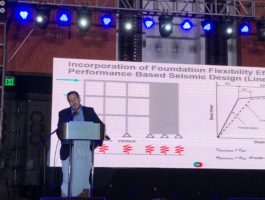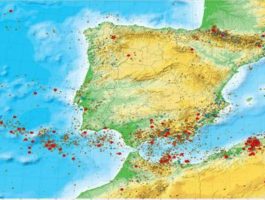FAISALIAH STRATEGIC FACILITY: SEISMIC DESIGN OF LARGE WATER TANKS
Dynamis has carried out the seismic design of the largest water tanks in the world together with the Intecsa-Inarsa engineering. These tanks have dimensions of 120 meters in diameter by 30 meters in height and are located in the city of Jeddah in Saudi Arabia.
A liquid-containing tank’s behavior under seismic loading is a complex phenomenon that reveals the following phenomena:
- Interaction between the fluid and the structure;
- Possible uplift of the tank (if it is not anchored);
- Interaction between the soil and the foundation of the tank;
- Soil deformation in the compressed side of the base due to the overturning moment generated by the seismic loads.
Due to inertial effects, the horizontal movement caused by the earthquake will generate a hydrodynamic fluid pressure that will be applied on the walls and on the bottom of the tank.
Such hydrodynamic pressures acting in a positive and negative direction will be superimposed onto the hydrostatic pressure generated by the fluid at rest.
Traditionally, hydrodynamic forces in a liquid tank system are evaluated using mechanical analogy in the form of spring-mass system, which simulates the impulsive and convective mode of vibration of a fluid tank system (Housner1963; Veletsos and Yang 1977).
The convective liquid sloshes independently of the tank wall and the impulsive liquid moves with (and deforms) the tank wall. The relative proportions of the convective and impulsive liquid depend on the ability of the tank to confine the liquid. The greater the confinement, the greater the impulsive liquid and lesser the convective liquid. The natural frequency of the convective vibration is low, but the natural frequency of the impulsive vibration is high. As a result, the convective liquid experiences low accelerations and high deformations, but the impulsive liquid experiences high accelerations and low deformations during seismic shaking. The convective liquid causes the free-surface to move up-and-down (slosh) but it does not apply significant pressures on the tank wall. The impulsive liquid applies pressures on the tank wall and induces seismic forces in the supports.
The first assumption is that the dynamic coupling between the impulsive mode and the convective mode is very low due to the great difference between their frequencies.
The second important assumption is to consider that the distributions of impulsive pressure field and the convective pressure field on the walls of the tank are identical to those calculated for a perfectly rigid tank. Thus, these pressures only depend on the geometry of the tank.
The frequencies corresponding to the impulsive and convective mode can be calculated by semi-empirical formulas defined by most seismic codes on liquid storage tanks (ACI 350.3, NZSEE, EC8).
Usually, the convection mode frequency depends only on the geometry of the tank, but the impulsive frequency depends on mechanical properties (Young’s modulus, etc), density of the stored fluid, as well as the geometry of the tank.
Knowing the frequencies of these modes, the spectral acceleration can easily be calculated using the response spectrum defined for the site. It is also possible to deduce the resulting seismic forces (FX, FY, FZ, MX, MY, MZ) in the base of the tank. Inertial forces generated in the wall’s tank will also be considered (relatively small compared to the one caused by the fluid).






